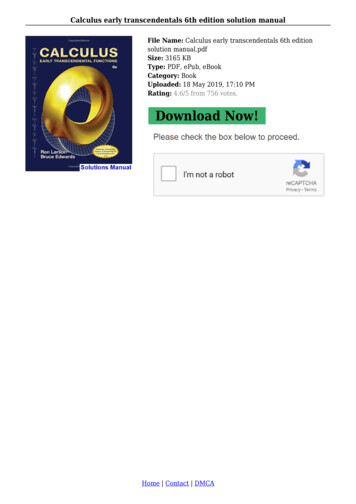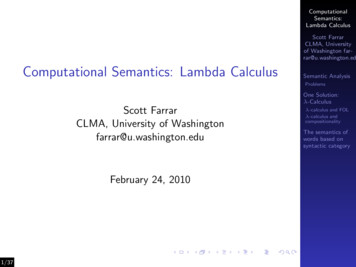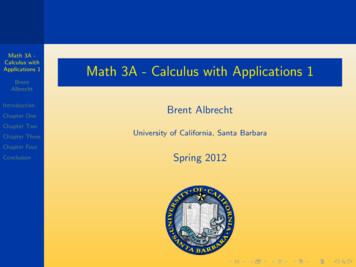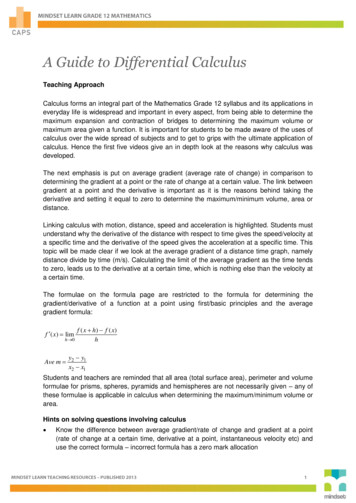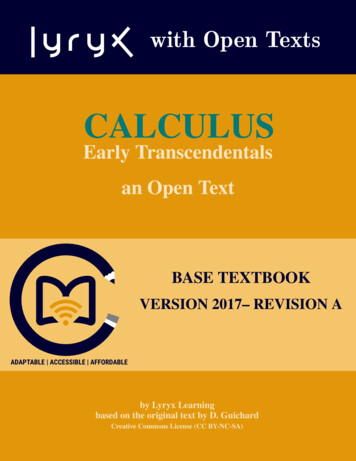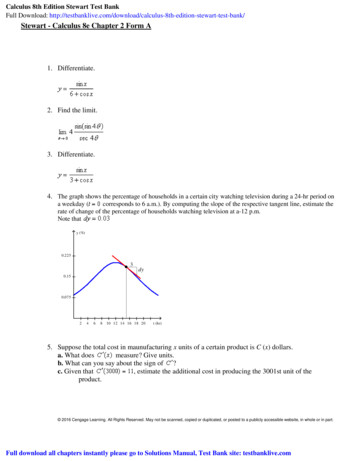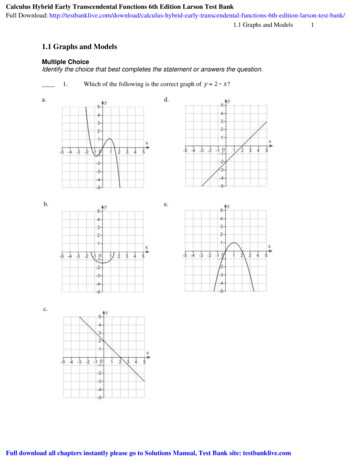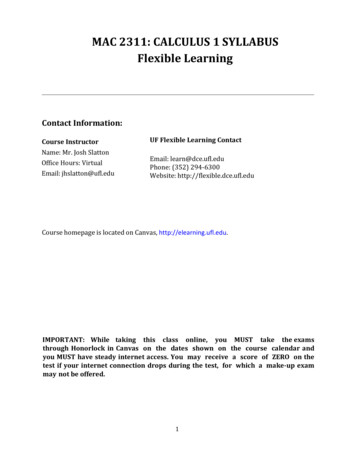
Transcription
Continue
Stewart calculus early transcendentals 6th edition answersBook Name: Student Solutions Manual for Stewart’s Single Variable Calculus: Early Transcendentals 6th Edition Author: James Stewart Publisher: Brooks Cole ISBN-10: 0495012408 Year: 2007 Pages: 1300 Language: English File size: 17 MB File format: PDF Student Solutions Manual for Stewart’s Single Variable Calculus: Early Transcendentals6th Edition Pdf Book Description: This book provide all answer that you need to know about Single Variable Calculus: Early Transcendentals that we provide for free download. we sure that student will need this solution manual to get the answer for all calculus question especially for odd numbered problems. DMCA Disclaimer: This site complies withDMCA Digital Copyright Laws. Please bear in mind that we do not own copyrights to these books. We’re sharing this material with our audience ONLY for educational purpose. We highly encourage our visitors to purchase original books from the respected publishers. If someone with copyrights wants us to remove this content, please contact usimmediately. All books on the edubookpdf.com are free and NOT HOSTED ON OUR WEBSITE. If you feel that we have violated your copyrights, then please contact us immediately (click here). We use cookies on our website to give you the most relevant experience by remembering your preferences and repeat visits. By clicking “Accept All”, youconsent to the use of ALL the cookies. However, you may visit "Cookie Settings" to provide a controlled consent.Cookie SettingsAccept AllManage consent File loading please wait. CA L C U L U S E A R LY T R A N S C E N D E N TA L S SIXTH EDITION JAMES STEWART McMASTER UNIVERSITY AUSTRALIA N BRAZIL N C A N A DA N MEXICO NSINGAPORE N S PA I N N UNITED KINGDOM N U N I T E D S TAT E S Calculus Early Transcendentals, 6e James Stewart Publisher Bob Pirtle Assistant Editor Stacy Green Editorial Assistant Elizabeth Rodio Technology Project Manager Sam Subity Marketing Manager Mark Santee Marketing Assistant Melissa Wong Marketing CommunicationsManager Bryan Vann Project Manager, Editorial Production Cheryll Linthicum Creative Director Rob Hugel Art Director Vernon T. Boes Print Buyer Becky Cross Permissions Editor Bob Kauser Production Service TECH·arts Text Designer Kathi Townes Photo Researcher Stephanie Kuhns Copy Editor Kathi Townes Illustrator Brian Betsill CoverDesigner Irene Morris Cover Image Amelie Fear, Folkmusician.com Cover Printer R. R. Donnelley /Willard Compositor Stephanie Kuhns, TECH·arts Printer R. R. Donnelley /Willard COPYRIGHT 2008, 2003 Thomson Brooks/Cole, a part of The Thomson Corporation. Thomson, the Star logo, and Brooks/Cole are trademarks used herein under license.Trademarks ExamView and ExamViewPro are registered trademarks of FSCreations, Inc. Windows is a registered trademark of the Microsoft Corporation and used herein under license. Macintosh and Power Macintosh are registered trademarks of Apple Computer, Inc. Used herein under license. Derive is a registered trademark of SoftWarehouse, Inc. Maple is a registered trademark of Waterloo Maple, Inc. Mathematica is a registered trademark of Wolfram Research, Inc. Tools for Enriching is a trademark used herein under license. N N N N N N N N N N N ALL RIGHTS RESERVED. No part of this work covered by the copyright hereon may be reproduced or used in any form orby any means—graphic, electronic, or mechanical, including photocopying, recording, taping, web distribution, information storage and retrieval systems, or in any other manner—without the written permission of the publisher. Printed in the United States of America N N N N N N N N N N N 1 2 3 4 5 6 7 11 10 09 08 07 For more information aboutour products, contact us at: Thomson Learning Academic Resource Center 1-800-423-0563 Thomson Higher Education 10 Davis Drive Belmont, CA 94002 USA For permission to use material from this text or product, submit a request online at Any additional questions about permissions can be submitted by email to [email protected] 2008 ThomsonLearning, Inc. All Rights Reserved. Thomson Learning WebTutor is a trademark of Thomson Learning, Inc. Library of Congress Control Number: 2006939532 K05T07 ISBN-13: 978-0-495-01166-8 ISBN-10: 0-495-01166-5 CONTENTS Preface xi To the Student xxiii Diagnostic Tests xxiv A PREVIEW OF CALCULUS 1 FUNCTIONS AND MODELS 101.1 Four Ways to Represent a Function 1.2 Mathematical Models: A Catalog of Essential Functions 1.3 New Functions from Old Functions 1.4 Graphing Calculators and Computers 1.5 Exponential Functions 1.6 Inverse Functions and Logarithms Review 11 37 46 52 59 76 LIMITS AND DERIVATIVES 82 2.1 The Tangent and Velocity Problems 2.2 TheLimit of a Function 2.3 Calculating Limits Using the Limit Laws 2.4 The Precise Definition of a Limit 2.5 Continuity 2.6 Limits at Infinity; Horizontal Asymptotes 2.7 Derivatives and Rates of Change 83 88 109 The Derivative as a Function Problems Plus 130 143 Writing Project Early Methods for Finding Tangents Review 99 119 N 2.8 24 73 Principlesof Problem Solving 2 2 153 154 165 170 iii iv CONTENTS 3 DIFFERENTIATION RULES 3.1 m 0 172 Derivatives of Polynomials and Exponential Functions Applied Project Building a Better Roller Coaster N m 1 m 1 0 π 2 π 3.2 The Product and Quotient Rules 3.3 Derivatives of Trigonometric Functions 3.4 The Chain Rule y 0 182 183 189 197Applied Project Where Should a Pilot Start Descent? 206 N π 2 3.5 Implicit Differentiation 3.6 Derivatives of Logarithmic Functions 3.7 Rates of Change in the Natural and Social Sciences 3.8 Exponential Growth and Decay 3.9 Related Rates 3.10 Linear Approximations and Differentials π 207 241 Laboratory Project Taylor Polynomials HyperbolicFunctions Review Problems Plus 4 247 253 254 261 265 APPLICATIONS OF DIFFERENTIATION 4.1 215 233 N 3.11 Maximum and Minimum Values 270 271 Applied Project The Calculus of Rainbows N 279 4.2 The Mean Value Theorem 4.3 How Derivatives Affect the Shape of a Graph 4.4 Indeterminate Forms and L’Hospital’s Rule 280 WritingProject The Origins of L’Hospital’s Rule N 4.5 Summary of Curve Sketching 4.6 Graphing with Calculus and Calculators 4.7 Optimization Problems 4.8 Newton’s Method 4.9 Antiderivatives Problems Plus 347 351 334 340 287 298 307 307 322 Applied Project The Shape of a Can N Review 173 333 315 221 CONTENTS 5 INTEGRALS 354 5.1 Areas andDistances 355 5.2 The Definite Integral 366 Discovery Project Area Functions N 379 5.3 The Fundamental Theorem of Calculus 379 5.4 Indefinite Integrals and the Net Change Theorem Writing Project Newton, Leibniz, and the Invention of Calculus N 5.5 The Substitution Rule Review Problems Plus 6 400 412 414 6.1 Areas between Curves 6.2Volumes 6.3 Volumes by Cylindrical Shells 6.4 Work 6.5 Average Value of a Function 415 422 433 438 442 Applied Project Where to Sit at the Movies N Problems Plus 7 399 408 INTEGRALS Review 391 446 446 448. TECHNIQUES OF INTEGRATION 452 7.1 Integration by Parts 453 7.2 Trigonometric Integrals 7.3 Trigonometric Substitution 7.4Integration of Rational Functions by Partial Fractions 7.5 Strategy for Integration 7.6 Integration Using Tables and Computer Algebra Systems 460 467 483 Discovery Project Patterns in Integrals N 473 494 489 v vi CONTENTS 7.7 Approximate Integration 7.8 Improper Integrals Review Problems Plus 8 495 508 518 521 FURTHERAPPLICATIONS OF INTEGRATION 8.1 Arc Length 525 Discovery Project Arc Length Contest N 8.2 532 Area of a Surface of Revolution Discovery Project Rotating on a Slant N 8.3 532 538 Applications to Physics and Engineering Discovery Project Complementary Coffee Cups N Applications to Economics and Biology 8.5 Probability Problems Plus 9539 550 8.4 Review 524 550 555 562 564 DIFFERENTIAL EQUATIONS 566 9.1 Modeling with Differential Equations 9.2 Direction Fields and Euler’s Method 9.3 Separable Equations 567 572 580 Applied Project How Fast Does a Tank Drain? N 588 Applied Project Which Is Faster, Going Up or Coming Down? N 9.4 Models for Population GrowthApplied Project Calculus and Baseball N 9.5 Linear Equations 9.6 Predator-Prey Systems Review Problems Plus 614 618 602 608 591 601 590 CONTENTS 10 PARAMETRIC EQUATIONS AND POLAR COORDINATES 10.1 Curves Defined by Parametric Equations Laboratory Project Running Circles around Circles N 10.2 Calculus with ParametricCurves Laboratory Project Bézier Curves N 11 639 Polar Coordinates 10.4 Areas and Lengths in Polar Coordinates 10.5 Conic Sections 10.6 Conic Sections in Polar Coordinates Problems Plus 639 650 654 662 669 672 INFINITE SEQUENCES AND SERIES 11.1 629 630 10.3 Review 621 Sequences 674 675 Laboratory Project Logistic Sequences 687N 11.2 Series 687 11.3 The Integral Test and Estimates of Sums 11.4 The Comparison Tests 11.5 Alternating Series 11.6 Absolute Convergence and the Ratio and Root Tests 11.7 Strategy for Testing Series 11.8 Power Series 11.9 Representations of Functions as Power Series 11.10 Taylor and Maclaurin Series 697 705 710 721 723 Laboratory ProjectAn Elusive Limit N 734 748 Writing Project How Newton Discovered the Binomial Series N 11.11 Applications of Taylor Polynomials Applied Project Radiation from the Stars N Review Problems Plus 758 761 728 749 757 748 714 620 vii viii CONTENTS 12 VECTORS AND THE GEOMETRY OF SPACE 12.1 Three-Dimensional CoordinateSystems 12.2 Vectors 12.3 The Dot Product 12.4 The Cross Product 764 765 770 O 779 786 Discovery Project The Geometry of a Tetrahedron N 12.5 LONDON Equations of Lines and Planes 794 Laboratory Project Putting 3D in Perspective N 12.6 Cylinders and Quadric Surfaces Review PARIS Problems Plus 13 804 804 812 815 VECTORFUNCTIONS 816 13.1 Vector Functions and Space Curves 13.2 Derivatives and Integrals of Vector Functions 13.3 Arc Length and Curvature 13.4 Motion in Space: Velocity and Acceleration Applied Project Kepler’s Laws Review Problems Plus 817 824 830 838 848 N 14 794 849 852 PARTIAL DERIVATIVES 854 14.1 Functions of Several Variables14.2 Limits and Continuity 14.3 Partial Derivatives 14.4 Tangent Planes and Linear Approximations 14.5 The Chain Rule 14.6 Directional Derivatives and the Gradient Vector 14.7 Maximum and Minimum Values 870 878 892 901 Applied Project Designing a Dumpster N 855 922 933 Discovery Project Quadratic Approximations and Critical Points N910 933 CONTENTS 14.8 Lagrange Multipliers 934 Applied Project Rocket Science 941 N Applied Project Hydro-Turbine Optimization 943 N Review Problems Plus 15 944 948 MULTIPLE INTEGRALS 950 15.1 Double Integrals over Rectangles 951 15.2 Iterated Integrals 15.3 Double Integrals over General Regions 15.4 Double Integrals in PolarCoordinates 15.5 Applications of Double Integrals 15.6 Triple Integrals 959 974 980 990 Discovery Project Volumes of Hyperspheres N 15.7 965 1000 Triple Integrals in Cylindrical Coordinates 1000 Discovery Project The Intersection of Three Cylinders 1005 N 15.8 Triple Integrals in Spherical Coordinates Applied Project Roller Derby N 15.9 1012Change of Variables in Multiple Integrals Review Problems Plus 16 1005 1012 1021 1024 VECTOR CALCULUS 1026 16.1 Vector Fields 1027 16.2 Line Integrals 1034 16.3 The Fundamental Theorem for Line Integrals 16.4 Green’s Theorem 16.5 Curl and Divergence 16.6 Parametric Surfaces and Their Areas 16.7 Surface Integrals 1081 16.8 Stokes’Theorem 1092 1055 1061 Writing Project Three Men and Two Theorems N 1070 1098 1046 ix x CONTENTS 16.9 The Divergence Theorem 16.10 Summary Review Problems Plus 17 1099 1105 1106 1109 SECOND-ORDER DIFFERENTIAL EQUATIONS 1110 17.1 Second-Order Linear Equations 17.2 Nonhomogeneous Linear Equations 17.3Applications of Second-Order Differential Equations 17.4 Series Solutions Review 1137 APPENDIXES A1 1111 1117 1133 A Numbers, Inequalities, and Absolute Values B Coordinate Geometry and Lines C Graphs of Second-Degree Equations D Trigonometry E Sigma Notation F Proofs of Theorems G The Logarithm Defined as an Integral H ComplexNumbers I Answers to Odd-Numbered Exercises INDEX A131 A10 A16 A24 A34 A39 A50 A57 A65 A2 1125 PREFACE A great discovery solves a great problem but there is a grain of discovery in the solution of any problem.Your problem may be modest; but if it challenges your curiosity and brings into play your inventive faculties, and if you solve it byyour own means, you may experience the tension and enjoy the triumph of discovery. G E O R G E P O LYA The art of teaching, Mark Van Doren said, is the art of assisting discovery. I have tried to write a book that assists students in discovering calculus—both for its practical power and its surprising beauty. In this edition, as in the first five editions,I aim to convey to the student a sense of the utility of calculus and develop technical competence, but I also strive to give some appreciation for the intrinsic beauty of the subject. Newton undoubtedly experienced a sense of triumph when he made his great discoveries. I want students to share some of that excitement. The emphasis is onunderstanding concepts. I think that nearly everybody agrees that this should be the primary goal of calculus instruction. In fact, the impetus for the current calculus reform movement came from the Tulane Conference in 1986, which formulated as their first recommendation: Focus on conceptual understanding. I have tried to implement this goalthrough the Rule of Three: “Topics should be presented geometrically, numerically, and algebraically.” Visualization, numerical and graphical experimentation, and other approaches have changed how we teach conceptual reasoning in fundamental ways. More recently, the Rule of Three has been expanded to become the Rule of Four by emphasizingthe verbal, or descriptive, point of view as well. In writing the sixth edition my premise has been that it is possible to achieve conceptual understanding and still retain the best traditions of traditional calculus. The book contains elements of reform, but within the context of a traditional curriculum. ALTERNATIVE VERSIONS I have written severalother calculus textbooks that might be preferable for some instructors. Most of them also come in single variable and multivariable versions. N N N Calculus, Sixth Edition, is similar to the present textbook except that the exponential, logarithmic, and inverse trigonometric functions are covered in the second semester. Essential Calculus is a muchbriefer book (800 pages), though it contains almost all of the topics in Calculus, Sixth Edition. The relative brevity is achieved through briefer exposition of some topics and putting some features on the website. Essential Calculus: Early Transcendentals resembles Essential Calculus, but the exponential, logarithmic, and inverse trigonometricfunctions are covered in Chapter 3. xi xii PREFACE N N Calculus: Concepts and Contexts, Third Edition, emphasizes conceptual understanding even more strongly than this book. The coverage of topics is not encyclopedic and the material on transcendental functions and on parametric equations is woven throughout the book instead of beingtreated in separate chapters. Calculus: Early Vectors introduces vectors and vector functions in the first semester and integrates them throughout the book. It is suitable for students taking Engineering and Physics courses concurrently with calculus. WHAT’S NEW IN THE SIXTH EDITION? Here are some of the changes for the sixth edition ofCalculus: Early Transcendentals. N N N N N N N At the beginning of the book there are four diagnostic tests, in Basic Algebra, Analytic Geometry, Functions, and Trigonometry. Answers are given and students who don’t do well are referred to where they should seek help (Appendixes, review sections of Chapter 1, and the website). In response torequests of several users, the material motivating the derivative is briefer: Sections 2.7 and 2.8 are combined into a single section called Derivatives and Rates of Change. The section on Higher Derivatives in Chapter 3 has disappeared and that material is integrated into various sections in Chapters 2 and 3. Instructors who do not cover the chapteron differential equations have commented that the section on Exponential Growth and Decay was inconveniently located there. Accordingly, it is moved earlier in the book, to Chapter 3. This move precipitates a reorganization of Chapters 3 and 9. Sections 4.7 and 4.8 are merged into a single section, with a briefer treatment of optimization problemsin business and economics. Sections 11.10 and 11.11 are merged into a single section. I had previously featured the binomial series in its own section to emphasize its importance. But I learned that some instructors were omitting that section, so I have decided to incorporate binomial series into 11.10. The material on cylindrical and sphericalcoordinates (formerly Section 12.7) is moved to Chapter 15, where it is introduced in the context of evaluating triple integrals. N New phrases and margin notes have been added to clarify the exposition. N A number of pieces of art have been redrawn. N The data in examples and exercises have been updated to be more timely. N N N N N Manyexamples have been added or changed. For instance, Example 2 on page 185 was changed because students are often baffled when they see arbitrary constants in a problem and I wanted to give an example in which they occur. Extra steps have been provided in some of the existing examples. More than 25% of the exercises in each chapter are new.Here are a few of my favorites: 3.1.79, 3.1.80, 4.3.62, 4.3.83, 11.6.38, 11.11.30, 14.5.44, and 14.8.20–21. There are also some good new problems in the Problems Plus sections. See, for instance, Problems 2 and 13 on page 413, Problem 13 on page 450, and Problem 24 on page 763. The new project on page 550, Complementary Coffee Cups, comesfrom an article by Thomas Banchoff in which he wondered which of two coffee cups, whose convex and concave profiles fit together snugly, would hold more coffee. PREFACE N N xiii Tools for Enriching Calculus (TEC) has been completely redesigned and is accessible on the Internet at www.stewartcalculus.com. It now includes what we callVisuals, brief animations of various figures in the text. In addition, there are now Visual, Modules, and Homework Hints for the multivariable chapters. See the description on page xiv. The symbol V has been placed beside examples (an average of three per section) for which there are videos of instructors explaining the example in more detail. Thismaterial is also available on DVD. See the description on page xxi. FEATURES CONCEPTUAL EXERCISES The most important way to foster conceptual understanding is through the problems that we assign. To that end I have devised various types of problems. Some exercise sets begin with requests to explain the meanings of the basic concepts ofthe section. (See, for instance, the first few exercises in Sections 2.2, 2.5, 11.2, 14.2, and 14.3.) Similarly, all the review sections begin with a Concept Check and a True-False Quiz. Other exercises test conceptual understanding through graphs or tables (see Exercises 2.7.17, 2.8.33–38, 2.8.41– 44, 9.1.11–12, 10.1.24–27, 11.10.2, 13.2.1–2, 13.3.33–37,14.1.1–2, 14.1.30–38, 14.3.3–10, 14.6.1–2, 14.7.3– 4, 15.1.5–10, 16.1.11–18, 16.2.17–18, and 16.3.1–2). Another type of exercise uses verbal description to test conceptual understanding (see Exercises 2.5.8, 2.8.56, 4.3.63–64, and 7.8.67). I particularly value problems that combine and compare graphical, numerical, and algebraic approaches (seeExercises 2.6.37–38, 3.7.25, and 9.4.2). GRADED EXERCISE SETS Each exercise set is carefully graded, progressing from basic conceptual exercises and skilldevelopment problems to more challenging problems involving applications and proofs. REAL-WORLD DATA My assistants and I spent a great deal of time looking in libraries, contactingcompanies and government agencies, and searching the Internet for interesting real-world data to introduce, motivate, and illustrate the concepts of calculus. As a result, many of the examples and exercises deal with functions defined by such numerical data or graphs. See, for instance, Figure 1 in Section 1.1 (seismograms from the Northridgeearthquake), Exercise 2.8.34 (percentage of the population under age 18), Exercise 5.1.14 (velocity of the space shuttle Endeavour), and Figure 4 in Section 5.4 (San Francisco power consumption). Functions of two variables are illustrated by a table of values of the wind-chill index as a function of air temperature and wind speed (Example 2 inSection 14.1). Partial derivatives are introduced in Section 14.3 by examining a column in a table of values of the heat index (perceived air temperature) as a function of the actual temperature and the relative humidity. This example is pursued further in connection with linear approximations (Example 3 in Section 14.4). Directional derivatives areintroduced in Section 14.6 by using a temperature contour map to estimate the rate of change of temperature at Reno in the direction of Las Vegas. Double integrals are used to estimate the average snowfall in Colorado on December 20–21, 2006 (Example 4 in Section 15.1). Vector fields are introduced in Section 16.1 by depictions of actual velocityvector fields showing San Francisco Bay wind patterns. PROJECTS One way of involving students and making them active learners is to have them work (perhaps in groups) on extended projects that give a feeling of substantial accomplishment when completed. I have included four kinds of projects: Applied Projects involve applications that aredesigned to appeal to the imagination of students. The project after Section 9.3 asks whether a ball thrown upward takes longer to reach its maximum height or to fall back to its original height. (The answer might surprise you.) The project after Section 14.8 uses Lagrange multipliers to determine the masses of the three stages of a rocket so as to xiv PREFACE minimize the total mass while enabling the rocket to reach a desired velocity. Laboratory Projects involve technology; the one following Section 10.2 shows how to use Bézier curves to design shapes that represent letters for a laser printer. Writing Projects ask students to compare present-day methods with those of the founders ofcalculus—Fermat’s method for finding tangents, for instance. Suggested references are supplied. Discovery Projects anticipate results to be discussed later or encourage discovery through pattern recognition (see the one following Section 7.6). Others explore aspects of geometry: tetrahedra (after Section 12.4), hyperspheres (after Section 15.6), andintersections of three cylinders (after Section 15.7). Additional projects can be found in the Instructor’s Guide (see, for instance, Group Exercise 5.1: Position from Samples). PROBLEM SOLVING Students usually have difficulties with problems for which there is no single well-defined procedure for obtaining the answer. I think nobody has improvedvery much on George Polya’s four-stage problem-solving strategy and, accordingly, I have included a version of his problem-solving principles following Chapter 1. They are applied, both explicitly and implicitly, throughout the book. After the other chapters I have placed sections called Problems Plus, which feature examples of how to tacklechallenging calculus problems. In selecting the varied problems for these sections I kept in mind the following advice from David Hilbert: “A mathematical problem should be difficult in order to entice us, yet not inaccessible lest it mock our efforts.” When I put these challenging problems on assignments and tests I grade them in a different way. HereI reward a student significantly for ideas toward a solution and for recognizing which problem-solving principles are relevant. TECHNOLOGY The availability of technology makes it not less important but more important to clearly understand the concepts that underlie the images on the screen. But, when properly used, graphing calculators andcomputers are powerful tools for discovering and understanding those concepts. This textbook can be used either with or without technology and I use two special symbols to indicate clearly when a particular type of machine is required. The icon ; indicates an exercise that definitely requires the use of such technology, but that is not to say that itcan’t be used on the other exercises as well. The symbol CAS is reserved for problems in which the full resources of a computer algebra system (like Derive, Maple, Mathematica, or the TI-89/92) are required. But technology doesn’t make pencil and paper obsolete. Hand calculation and sketches are often preferable to technology for illustrating andreinforcing some concepts. Both instructors and students need to develop the ability to decide where the hand or the machine is appropriate. TOOLS FOR ENRICHING CALCULUS TEC is a companion to the text and is intended to enrich and complement its contents. (It is now accessible from the Internet at www.stewartcalculus.com.) Developed byHarvey Keynes, Dan Clegg, Hubert Hohn, and myself, TEC uses a discovery and exploratory approach. In sections of the book where technology is particularly appropriate, marginal icons direct students to TEC modules that provide a laboratory environment in which they can explore the topic in different ways and at different levels. Visuals areanimations of figures in text; Modules are more elaborate activities and include exercises. Instructors can choose to become involved at several different levels, ranging from simply encouraging students to use the Visuals and Modules for independent exploration, to assigning specific exercises from those included with each Module, or to creatingadditional exercises, labs, and projects that make use of the Visuals and Modules. TEC also includes Homework Hints for representative exercises (usually oddnumbered) in every section of the text, indicated by printing the exercise number in red. These hints are usually presented in the form of questions and try to imitate an effective teachingassistant by functioning as a silent tutor. They are constructed so as not to reveal any more of the actual solution than is minimally necessary to make further progress. PREFACE xv ENHANCED W EB A SSIGN Technology is having an impact on the way homework is assigned to students, particularly in large classes. The use of online homework isgrowing and its appeal depends on ease of use, grading precision, and reliability. With the sixth edition we have been working with the calculus community and WebAssign to develop an online homework system. Up to 70% of the exercises in each section are assignable as online homework, including free response, multiple choice, and multi-partformats. The system also includes Active Examples, in which students are guided in step-by-step tutorials through text examples, with links to the textbook and to video solutions. WEBSITE www.stewartcalculus.com This site has been renovated and now includes the following. N Algebra Review N Lies My Calculator and Computer Told Me N Historyof Mathematics, with links to the better historical websites N N Additional Topics (complete with exercise sets): Fourier Series, Formulas for the Remainder Term in Taylor Series, Rotation of Axes Archived Problems (Drill exercises that appeared in previous editions, together with their solutions) N Challenge Problems (some from the Problems Plussections from prior editions) N Links, for particular topics, to outside web resources N The complete Tools for Enriching Calculus (TEC) Modules, Visuals, and Homework Hints CONTENT 1 2 Diagnostic Tests The book begins with four diagnostic tests, in Basic Algebra, Analytic Geometry, Functions, and Trigonometry. A Preview of Calculus This is anoverview of the subject and includes a list of questions to motivate the study of calculus. Functions and Models From the beginning, multiple representations of functions are stressed: verbal, numerical, visual, and algebraic. A discussion of mathematical models leads to a review of the standard functions, including exponential and logarithmicfunctions, from these four points of view. Limits and Derivatives The material on limits is motivated by a prior discussion of the tangent and velocity problems. Limits are treated from descriptive, graphical, numerical, and algebraic points of view. Section 2.4, on the precise - definition of a limit, is an optional section. Sections 2.7 and 2.8 deal withderivatives (especially with functions defined graphically and numerically) before the differentiation rules are covered in Chapter 3. Here the examples and exercises explore the meanings of derivatives in various contexts. Higher derivatives are now introduced in Section 2.8. Differentiation Rules All the basic functions, including exponential,logarithmic, and inverse trigonometric functions, are differentiated here. When derivatives are computed in applied situations, students are asked to explain their meanings. Exponential growth and decay are now covered in this chapter. N N 3 N xvi 4 N PREFACE Applications of Differentiation The basic facts concerning extreme values andshapes of curves are deduced from the Mean Value Theorem. Graphing with technology emphasizes the interaction between calculus and calculators and the analysis of families of curves. Some substantial optimization problems are provided, including an explanation of why you need to raise your head 42 to see the top of a rainbow. Integrals Thearea problem and the distance problem serve to motivate the definite integral, with sigma notation introduced as needed. (Full coverage of sigma notation is provided in Appendix E.) Emphasis is placed on explaining the meanings of integrals in various contexts and on estimating their values from graphs and tables. Applications of Integration Here Ipresent the applications of integration—area, volume, work,
Stewart calculus early transcendentals 6th edition answers Book Name: Student Solutions Manual for Stewart's Single Variable Calculus: Early Transcendentals 6th Edition Author: James Stewart Publisher: Brooks Cole ISBN-10: 0495012408 Year: 2007 Pages: 1300 Language: English File size: 17 MB File format: PDF Student Solutions Manual for .
